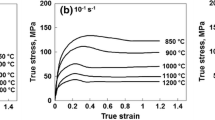Abstract
The brittle-ductile transition for a high nitrogen steel is investigated by numerical analyses of the Charpy impact test. The material is described in terms of an elastic-viscoplastic constitutive model that accounts for the nucleation and growth of micro-voids, leading to ductile fracture, as well as for cleavage failure by micro-crack nucleation. The temperature dependence of flow strength and strain hardening is included in the model, and this leads to the prediction of a transition from cleavage fracture to predominantly ductile fracture as the temperature increases. For the particular steel considered it is found that the variation of strain hardening with temperature has a strong effect on the failure mode transition. Both slow loading and impact loading of the Charpy specimen are analyzed. Most of the computations are based on a quasi-static formulation since, even at the strain rates encountered in the Charpy impact test, material strain rate sensitivity is the main time effect. The influence of material inertia is investigated in a few transient analyses.
Résumé
On étudie la transition ductile-fragile d'un acier à haute teneur en azote par l'analyse numérique de resultats d'essais de résilience Charpy. On décrit le matériau sous forme d'un modèle constitutif élasto-viscoplastique, qui tient compte de la création et de la croissance de micro-lacunes conduisant à une rupture ductile ou à une rupture par clivage par nucléation de microfissures. On induit dans le modèle la dépendance de la limite elastique et de l'écrouissage par rapport à la température, ce qui conduit à prédire une transition d'une rupture par clivage à une rupture essentiellement ductile lorsque croît la température. Pour l'acier considéré en particulier, on trouve que l'évolution de l'écrouissage avec la température a un effet déterminant sur la transition du mode de rupture. On analyse à la fois la mise en charge lente et brutale de l'échantillon Charpy. La plupart des calculs sont basés sur une formulation en conditions quasi-statiques puisque la sensibilité du matériau à la vitesse de deformation est le facteur principal du point de vue du temps, même aux vitesses de déformation caractéristiques de l'essai de résilience Charpy V. Dans quelques analyses de transitoires, on étudie l'influence de l'inertie du matériau.
Similar content being viewed by others
References
S.T. Rolfe and J.M. Barsom, Fracture and Fatigue Control in Structures-Applications of Fracture Mechanics, Prentice Hall, Englewood Cliffs, NJ (1977).
V. Tvergaard and A. Needleman, Journal of the Mechanics and Physics of Solids 34 (1986) 213–241.
A.L. Gurson, Plastic Flow and Fracture Behavior of Ductile Materials Incorporating Void Nucleation, Growth and Interaction, PhD thesis, Brown University (1975).
A.L. Gurson, Journal of Engineering Materials and Technology 99 (1977) 2–15.
R.O. Ritchie, J.F. Knott and J.R. Rice, Journal of the Mechanics and Physics of Solids 21 (1973) 395–410.
G.T. Hahn, Metallurgical Transactions 15A (1984) 947–959.
J.W. Hutchinson, Micro-Mechanics of Damage in Deformation and Fracture, Department of Solid Mechanics, Technical University of Denmark (1987).
D.M. Norris, Engineering Fracture Mechanics 11 (1979) 261–274.
J. Pan, M. Saje and A. Needleman, International Journal of Fracture 21 (1983) 261–278.
A. Needleman and V. Tvergaard, in Mechanical Behavior of Materials — IV, J. Carlsson and N.G. Ohlson (eds.), Pergamon Press, Oxford (1984) 51–65.
A. Needleman and V. Tvergaard, Journal of the Mechanics and Physics of Solids 35 (1987) 151–183.
V. Tvergaard, International Journal of Fracture 17 (1981) 389–407.
V. Tvergaard, International Journal of Fracture 18 (1982) 237–252.
V. Tvergaard and A. Needleman, Acta Metallurgica 32 (1984) 157–169.
C.C. Chu and A. Needleman, Journal of Engineering Materials and Technology 102 (1980) 249–256.
A.H. Cottrell, Transactions AIME, 212 (1958) 192–203.
N.J. Petch, Philosophical Magazine 3 (1958) 1089–1097.
E. Smith, International Journal of Fracture Mechanics 4 (1968) 131–145.
T. Belytchko, R.L. Chiapetta and H.D. Bartel, International Journal for Numerical Methods in Engineering 10 (1976) 579–596.
R.D. Krieg and S.W. Key, International Journal for Numerical Methods in Engineering 7 (1973) 273–286.
H. Kolsky, Stress Waves in Solids, Dover Publications, New York, NY (1963).
V. Tvergaard, Journal of the Mechanics and Physics of Solids 30 (1982) 399–425.
A. Needleman and V. Tvergaard, in Plastic Instability, J. Salencon (ed.) (1985) 251–262.
D.J. Ayers, International Journal of Fracture 12 (1976) 567–578.
J.R. Rice, Journal of Applied Mechanics 35 (1968) 379–386.
J.D. Eshelby, in Inelastic Behavior of Solids, M.F. Kanninen et al. (eds.), McGraw-Hill, New York, NY (1970) 77–115.
D.M. Norris, D.F. Quinones and B. Moran, in What Does the Charpy Test Really Tell Us?, A.R. Rosenfield et al. (eds.), ASM Metals Park, OH (1978) 22–32.
R.O. Ritchie, in What Does the Charpy Test Really Tell Us?, A.R. Rosenfield et al. (eds.), ASM Metals Park, OH (1978) 54–73.
S. Lee, R.J. Asaro, Metallurgical Transactions 16A (1985) 1633–1648.
Author information
Authors and Affiliations
Rights and permissions
About this article
Cite this article
Tvergaard, V., Needleman, A. An analysis of the temperature and rate dependence of Charpy V-notch energies for a high nitrogen steel. Int J Fract 37, 197–215 (1988). https://doi.org/10.1007/BF00045863
Received:
Accepted:
Issue Date:
DOI: https://doi.org/10.1007/BF00045863




